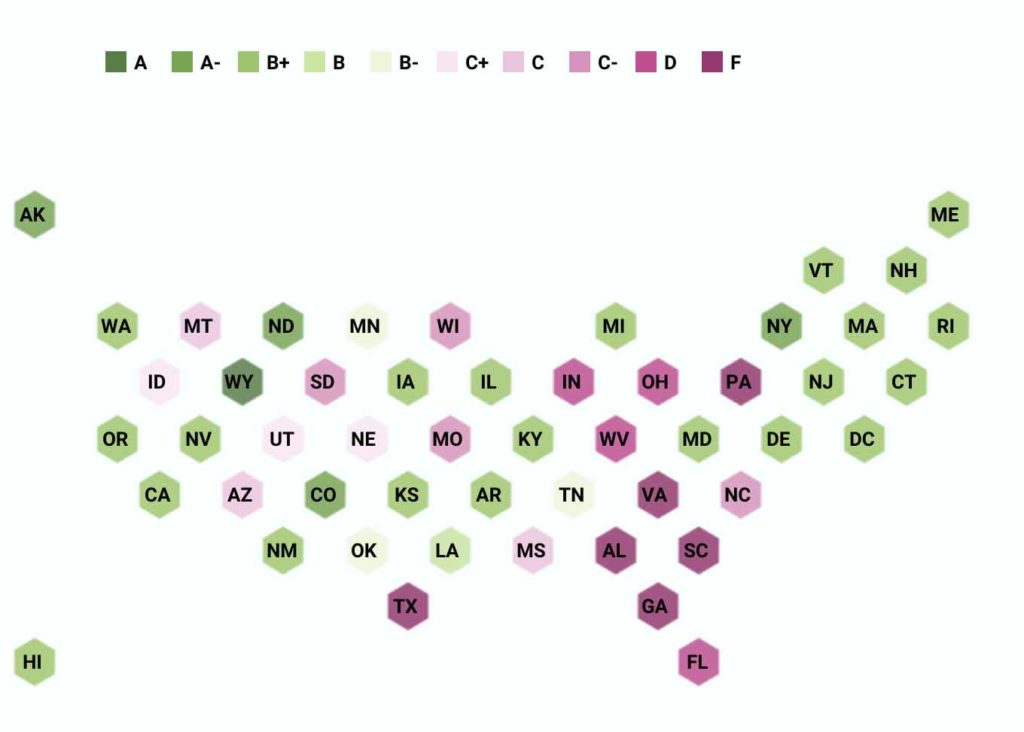If you’re considering launching an effort to get climate change education more embedded in your state’s education system, we’ve assembled some tools to help:
1) Key Elements of State Legislation
Getting climate change into state education standards is just a start. Those standards need to then translate into what actually happens in classrooms, which requires professional development and other forms of support for teachers, such as model curricula, great textbooks, and field experience opportunities.
Teachers need to devote more than a couple of classes each year to the topic, which is often the norm today. Students need a coherent and effective sequence of learning throughout their high school and college career, not just a little bit here and there, if they are to become truly literate.
In order to change what actually happens in any particular classroom, state climate education policy must address the following:
The formal and nonformal education communities need to come together with the state department of education to define the most important concepts and principals which a climate literate graduate should know. All stakeholders must agree on the essential climate concepts that they are all trying, each in their own way, to teach. Otherwise, a graduate may have had exposure to a good amount of climate-related material over the course of their high school career and still not be literate.
Subject standards are essentially the rules of the game: they tell teachers what the state thinks they should be teaching. Assessments (tests) drive much of what is taught in the classroom. So these two are key leverage points; getting climate infused into standards and assessments is critical.
Professional development for teachers is often overlooked by policy-makers. As a result, since many education policies put into place have no penalties for not following those policies, and since many policies are established without providing the funding to carry them out, policies often fail to change what happens in the classroom.
Some teachers resist using curricula developed by others, preferring to make it just the way they’d like it; but many teachers, short on time to create curricula on their own that also aligns well with state standards, welcome the help that model curricula offer.
Change is expensive. Requiring change without also providing the resources to accomplish it is called an “unfunded mandate”, which generally means that no change takes place. There are a number of creative ways to provide revenue for change: ee license plates, (need to finish this)
The brass ring of state policy is a climate literacy graduation requirement. Anything short of that and too many students will slip through the cracks or what education students get will likely be seriously incomplete. At the same time, a graduation requirement mandated by the state will be ignored by schools and districts unless most of not all the elements above are put into place
2) Assess your state
Members of your state legislature will be very interested to understand how much support there is for CCE within their constituency. You can drill down to the county level on this comprehensive climate public opinion map to find that out. Then make that information part of your communication with a particular state senator or representative.
In increasing numbers public opinion is with us.
See all questions from the Yale Climate Opinion Maps 2020 – Yale Program on Climate Change Communication here.
Having trouble viewing this? See direct link here.
See what grade your state has below from the CimateGrades Report. Pop-up the interactive map
Assess your state standards
Finally, two interesting studies have recently been done on aspects of state climate change education which may provide you with helpful ammunition as you seek to build your case.
“Making the Grade?” by the National Center for Science Education and the Texas Freedom Network Education Fund is a comparative study of how each state’s science standards address climate change.
“A State Policy Landscape: K12 Climate Action” by The Aspen Institute looks at key areas where states have policies that can support schools in moving toward climate action. Check both to see how your state did.

3) Make the Case
- The heaviest burden of climate change impacts will fall on the next generation. We must at least provide them with the skills and knowledge to be able to deal with this burden.
- Nearly 3,000,000 students graduate from our nation’s schools and colleges each year, armed with attitudes, skills, and knowledge about the climate that inform their actions. The effects on the climate, positive or negative, of each of those 3,000,000 students will last a lifetime.
- Those students need to be prepared to implement changes in professional and personal practices, to support and help develop new technology and policy, support new policy, and to address the coming social and economic challenges and opportunities arising from a changing climate. It is thus essential that each of these graduates are climate literate.
- While some say climate education will take too long to have much impact on CO2 levels, a study published recently in Nature demonstrated that children who take a climate education curriculum foster climate change concern among their parents.
- According to the Yale and George Mason Universities Program on Climate Change Communications, nearly 80 percent of parents in the U.S. support teaching students about the causes, consequences, and potential solutions to climate change.
- According to a recent National Public Radio/IPSOS poll, 86 percent of teachers in the United States feel that climate change should be taught in schools.
- The National Science Teaching Association, the National Association of Geoscience Teachers, the National Association of Biology Teachers, as well as other professional organizations have all called for greater support for science educators in teaching climate science and climate change.
- In the 2020 Proceedings of the National Academies of Science, Engineering and Medicine, scientists picked climate education as one of six key societal transformations needed to address the climate crisis. The paper called for a massive climate literacy campaign to strengthen education about k-16 climate change to produce a generation of workers and leaders who are focused on stopping climate change, as well as better education of the general public.
- In a survey by the Kaiser Family Foundation and Washington Post, 61% of American teenagers say the issue of climate change is very or extremely important to them personally, yet nearly 40% mistakenly believe that “the sun getting hotter” is a major contributor to climate change. Nearly half say they have learned either a little or nothing about the causes or ways to reduce the effects of climate change.
- We need climate-literate voters who will support sound climate policy.
- We need climate-literate consumers to help create demand for low-carbon products while making their lifestyles more climate-friendly.
- We need a climate-literate professional workforce who will bring climate smart thinking into their jobs as architects, builders, engineers, planners, scientists, business managers, financial experts, lawyers, entrepreneurs, investors, political leaders, policy makers, resource managers – to name just a few.
- We need climate-literate workers to help keep the U.S. well positioned in global markets as these markets increasingly value sustainability
- We need climate-literate entrepreneurs who will discover and create innovative climate solutions.
- We need a climate-literate public who will pitch in to do their part in reducing greenhouse gases and mitigate climate change impacts.
Need help with a state bill?
We may be able to help you with legislation design and strategy


